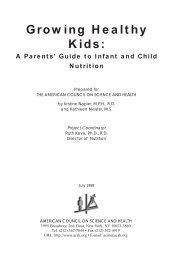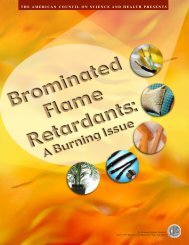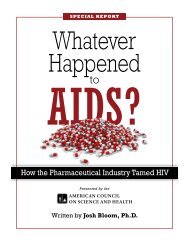The Role of Beef in the American Diet - International Meat Secretariat
The Role of Beef in the American Diet - International Meat Secretariat
The Role of Beef in the American Diet - International Meat Secretariat
Create successful ePaper yourself
Turn your PDF publications into a flip-book with our unique Google optimized e-Paper software.
<strong>The</strong> <strong>Role</strong> <strong>of</strong> <strong>Beef</strong> <strong>in</strong> <strong>the</strong> <strong>American</strong> <strong>Diet</strong><br />
changes. Precautions should be taken to ensure that dripp<strong>in</strong>gs from<br />
raw meats, which may conta<strong>in</strong> harmful bacteria, do not contam<strong>in</strong>ate<br />
o<strong>the</strong>r foods.<br />
• <strong>The</strong> process <strong>of</strong> irradiation has been approved as a means <strong>of</strong> enhanc<strong>in</strong>g<br />
<strong>the</strong> microbiological safety <strong>of</strong> meat and poultry, <strong>in</strong>clud<strong>in</strong>g beef.<br />
<strong>The</strong> <strong>in</strong>creased use <strong>of</strong> this process would have important benefits for<br />
consumers, particularly <strong>in</strong> ensur<strong>in</strong>g <strong>the</strong> safety <strong>of</strong> ground meats.<br />
• Some countries outside North America are currently experienc<strong>in</strong>g<br />
serious problems with two cattle diseases: bov<strong>in</strong>e spongiform<br />
encephalopathy (BSE) and foot-and-mouth disease. BSE can be<br />
transmitted to humans <strong>in</strong> rare <strong>in</strong>stances; foot-and-mouth disease is<br />
not a human health problem. Nei<strong>the</strong>r disease is present <strong>in</strong> <strong>the</strong> U.S.,<br />
and precautions are be<strong>in</strong>g taken to keep both out <strong>of</strong> <strong>the</strong> country. U.S.<br />
consumers need not be concerned about <strong>the</strong>se diseases except when<br />
travel<strong>in</strong>g to affected parts <strong>of</strong> <strong>the</strong> world.<br />
• Although producers <strong>of</strong> “natural” and “organic” beef products use<br />
production methods that differ from conventional ones, <strong>the</strong>se types<br />
<strong>of</strong> beef have not been shown to differ from o<strong>the</strong>r beef <strong>in</strong> terms <strong>of</strong><br />
nutrition or safety. Grass-fed beef differs somewhat from conventionally<br />
raised (gra<strong>in</strong>-f<strong>in</strong>ished) beef <strong>in</strong> that its fatty acid pr<strong>of</strong>ile is more<br />
desirable. However, <strong>the</strong> impact <strong>of</strong> this small difference on consumers’<br />
overall diets is uncerta<strong>in</strong>, and grass-fed beef does not <strong>of</strong>fer<br />
any special advantages <strong>in</strong> terms <strong>of</strong> safety.<br />
7










